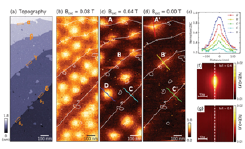Imaging of Josephson Vortices on Surface Superconductor by Scanning Tunneling Microscopy
T. Uchihashi, X. Hu, and Y. Hasegawa
The recent discovery of superconductivity in silicon surface reconstructions with metal adsorbates was an unexpected surprise, and as an ultimately thin 2D superconductor extensive studies on their properties are in progress [1-4]. One ubiquitous feature of these systems is the presence of atomic steps, which may strongly affect electron transport there. Recent direct electron transport measurements indicated that atomic steps work as Josephson junctions [2]. Nevertheless, direct evidence of Josephson coupling has not been obtained yet, and possible local variation of its strength has remained an open issue.

Fig. 1. (a) Large-scale STM image of Si(111)-(√7×√3)-In surface, where the terraces are separated by atomic steps marked as α, β, γ, and δ from top to bottom. (b)-(d) ZBC images taken under magnetic fields of (b) 0.08 T, (c) 0.04 T, (d) 0 T. The positions of the atomic steps are depicted by thin solid lines. (e) Spatial profiles of ZBC plotted along the thick solid lines shown in (c) and (d). (f) and (g) numerically obtained spatial profile of the zero energy DOS for the hopping strength ts/t = 0.4 and 0.1, respectively. The dashed lines indicate the place where the Josephson coupling was modeled.
Here, we report on compelling evidence of the Josephson coupling at atomic steps on the surface superconductor Si(111)-(√7× √3)-In [5]. Zero-bias conductance (ZBC) images, which correspond to a mapping of the density of states (DOS) at the Fermi level, taken with a low-temperature scanning tunneling microscopy (STM) reveal that vortices are present at atomic steps after magnetic fields are applied. Elongated shapes and significant recovery of superconductivity within their cores, which are characteristic to Josephson vortices (JV), are clearly observed in the images.
Figure 1(a) shows an STM image with an area of 500 nm×1500 nm. The surface consists of flat terraces separated by single atomic height steps. ZBC images taken on the same area under magnetic fields of 0.08, 0.04, 0 T are displayed in Figs. 1(b)-1(d). The imagings were performed below 0.5 K, which is sufficiently lower than Tc ≈ 3 K of the superconducting surface. At 0.08 T, round vortices formed a closely packed triangular lattice within each terrace. Reduction of the magnetic field to 0.04 T decreased the number of vortices as expected. When the magnetic field was set to zero, vortices disappeared from the terraces, but slightly bright regions remained along the steps [Fig. 1(d)]. Note that similar features were also present along the steps at finite fields [Figs. 1(b) and 1(c)]. They are not simply regions where superconductivity is suppressed due to the presence of steps because the features change their positions under different magnetic fields, as seen from A and A'. These observations clearly show that these bright features are vortices trapped at the atomic steps.
The vortices at steps are anomalous compared to the vortices on terraces. First, their shapes are elongated along the steps whereas the vortices on terraces are round. Second, ZBC values measured at the centers are lower than those of the vortices on terraces, as quantitatively depicted in Fig. 1(e). These anomalies are the direct consequences of JV and show that the atomic steps work as Josephson junctions.
Suppose that a vortex is created by penetration of the magnetic field through a Josephson junction line and its surrounding region. At the junction, the critical current density Jc is suppressed from that of the superconducting regions J0. This leads to two important properties regarding the vortex [6]. First, the circulation of supercurrent near the center is strongly deformed and the vortex core is elongated along the junction line by a factor of (Jc/J0)−1. Second, the breaking of superconductivity around the core is weakened as Jc/J0 decreases. When the supercurrent distribution near the junction line is nearly parallel and the suppression is sufficiently small, the vortex should be called a JV, like the case of layered superconductors under magnetic field parallel to the layers [7].
To ensure this picture, we numerically calculated the order parameter and DOS using the Bogoliubov-de Gennes (BdG) equation for a 2D tight-binding model with the hopping strength ts at the Josephson junction reduced from a constant hopping strength t elsewhere. Then the Josephson parameter Jc/J0 is represented by the ratio ts/t. Figures 1(f) and 1(g) display zero-energy DOS calculated for ts/t = 0.4 and 0.1, respectively. The characteristics of zero-energy DOS are different from the case of ts/t = 1; its magnitude around the center is decreased as ts/t is reduced, while the spatial distribution becomes strongly elliptic, which directly corresponds to the observed changes for vortices A', B', and C' in Fig. 1(d). From the comparison of the experiment and the theory, Jc/J0 is estimated to be ~ 0.4 for step γ where vortex B' is located. Because of a weaker coupling at step δ, vortex C' can be safely called a JV.
References
- [1] T. Zhang et al., Nat. Phys. 6, 104 (2010).
- [2] T. Uchihashi, P. Mishra, M. Aono, and T. Nakayama, Phys. Rev. Lett. 107, 207001 (2011).
- [3] M. Yamada, T. Hirahara, and S. Hasegawa, Phys. Rev. Lett. 110, 237001 (2013).
- [4] C. Brun et al., Nat. Phys. 10, 444 (2014).
- [5] S. Yoshizawa, H. Kim, T. Kawakami, Y. Nagai, T. Nakayama, X. Hu, Y. Hasegawa, and T. Uchihashi, Phys. Rev. Lett. 113, 247004 (2014).
- [6] G. Blatter, M. V. Feigel’man, V. B. Geshkenbein, A. I. Larkin, and V. M. Vinokur, Rev. Mod. Phys. 66, 1125 (1994).
- [7] P. J. W. Moll, L. Balicas, V. Geshkenbein, G. Blatter, J. Karpinski, N. D. Zhigadlo, and B. Batlogg, Nat. Mater. 12, 134 (2013).
